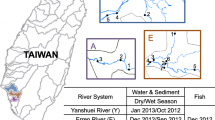Abstract
In vitro reporter gene assays using vertebrate cell lines or yeast have been used for assessment of the estrogenic chemicals. However, estrogen receptor α (ERα)- and ERβ-mediated reporter gene system in fish has yet to be developed. In the present study, we developed an ERα- and ERβ-mediated reporter gene assay in fish and estimated estrogenic activities of 17β-estradiol (E2), p-nonylphenol (NP), bisphenol A (BPA), p,p′-DDE, and genistein (Gen) using the in vitro reporter assay. The activity was intensely induced by transfection with either ERα or ERβ expression plasmid under E2 or Gen administration, whereas it was significantly induced by transfection with ERα expression plasmid, but not with ERβ expression plasmid under NP administration. On the other hand, the activity was induced more intensely by transfection with ERα expression plasmid than ERβ expression plasmid under BPA or p,p′-DDE administration. These results indicate that there are obvious differences in the activity through ERα and ERβ among the estrogenic chemicals examined in vitro. Thus, the in vitro reporter assay provides an excellent system for elucidating the action mechanism of estrogenic chemicals in fishes.




Similar content being viewed by others
References
Ackermann GE, Brombacher E, Fent K (2002) Development of a fish reporter gene system for the assessment of estrogenic compounds and sewage treatment plant effluents. Environ Toxicol Chem 21:1864–1875
Chang XT, Kobayashi T, Todo T, Ikeuchi T, Yoshiura M, Kajiura-Kobayashi H, Morrey C, Nagahama Y (1999) Molecular cloning of estrogen receptors α and β in the ovary of a teleost fish, the tilapia (Oreochromis niloticus). Zool Sci 16:653–658
Felsenstein J (1995) “PHYLIP (Phlogeny Inference Package),” Version 3.573c. Distributed by author, University of Washington
Hawkins MB, Thornton JW, Crew D, Skipper JK, Dotte A, Thomas P (2000) Identification of a third distinct estrogen receptor and reclassification estrogen receptors in teleost. Proc Natl Acad Sci USA 97:10751–10756
Kitano T, Takamune K, Kobayashi T, Nagahama Y, Abe S-I (1999) Suppression of P450 aromatase gene expression in sex-reversed males produced by rearing genetically female larvae at a high water temperature during a period of sex differentiation in the Japanese flounder (Paralichthys olivaceus). J Mol Endocrinol 23:167–176
Kuiper GGJM, Enmark E, Pelto-Huikko M, Nilsson S, Gustafsson JA (1996) Cloning of a novel estrogen receptor expressed in rat prostate and ovary. Proc Natl Acad Sci USA 93:5925–5930
Kuiper GGJM, Lemmen JG, Carlsson B, Corton JC, Safe SH, van der Saag PT, van der Burg B, Gustafsson JA (1998) Interaction of estrogenic chemicals and phytoestrogens with estrogen receptor β. Endocrinology 139:4252–4263
Marin MG, Matozzo V (2004) Vitellogenin induction as a biomarker of exposure to estrogenic compounds in aquatic environments. Mar Pollut Bull 48:835–839
Meerts IATM, Letcher RJ, Hoving S, Marsh G, Bergman Å, Lemmen JG, Van der Burg B, Brouwer A (2001) In vitro estrogenicity of polybrominated diphenyl ethers, hydroxylated PBDEs, and polybrominated bisphenol A compounds. Environ Health Perspect 109:399–407
Menuet A, Pellegrini E, Anglade I, Blaise O, Laudet V, Kah O, Pakdel F (2002) Molecular characterization of three estrogen receptor forms in zebrafish: binding characteristics, transactivation properties, and tissue distributions. Biol Reprod 66:1881–1892
Mosselman S, Polman J, Dijkema R (1996) ERβ: identification and characterization of a novel human estrogen receptor. FEBS Lett 392:49–53
Ng TB, Idler DR (1983) Yolk formation and differentiation in teleost fishes. In: Hoar WS, Randall DJ, Donaldson EM (eds) Fish physiology, vol 9A. Academic, New York, pp 373–404
Routledge EJ, Sumpter JP (1996) Estrogenic activity of surfactants and some of their degradation products assessed using a recombinant yeast screen. Environ Toxicol Chem 15:241–248
Saitou N, Nei M (1987) The neighbor-joining method: a new method for reconstructing phylogenetic trees. Mol Biol Evol 4:406–425
Seiler-Tuyns A, Mérillat AM, Haefliger DN, Wahli W (1988) The human estrogen receptor can regulate exogenous but not endogenous vitellogenin gene promoters in a Xenopus cell line. Nucleic Acids Res 16:8291–8305
Shimasaki Y, Kitano T, Oshima Y, Inoue S, Imada N, Honjo T (2002) Tributyltin causes masculinization in fish. Environ Toxicol Chem 22:141–144
Socorro S, Power DM, Olsson P-E, Canario AVM (2000) Two estrogen receptors expressed in the teleost fish, Sparus aurata: cDNA cloning, characterization and tissue distribution. J Endocrinol 166:293–306
Tabata K (1991) Induction of gynogenetic diploid males and presumption of sex determination mechanisms in the hirame, Paralichthys olivaceus. Bull Jpn Soc Sci Fish 57:845–850
Teo BY, Tan NS, Lim EH, Lam TJ, Ding JL (1998) A novel piscine vitellogenin gene: structural and functional analyses of estrogen-inducible promoter. Mol Cell Endocrinol 146:103–120
Thompson JD, Higgins DG, Gibson TJ (1994) CLUSTAL W: improving the sensitivity of progressive multiple sequence alignment through sequence weighting, position-specific gap penalties and weight matrix choice. Nucleic Acids Res 22:4673–4680
Walker P, Germond JE, Brown-Luedi M, Givel F, Wahli W (1984) Sequence homologies in the region preceding the transcription initiation site of the liver estrogen-responsive vitellogenin and apo-VLDLII genes. Nucleic Acids Res 12:8611–8626
White R, Jobling S, Hoare SA, Sumpter JP, Parker MG (1994) Environmentally persistent alkylphenolic compounds are estrogenic. Endocrinology 135:175–182
Xia Z, Patiño R, Gale WL, Maule AG, Densmore LD (1999) Cloning, in vitro expression, and novel phylogenetic classification of a channel catfish estrogen receptor. Gen Comp Endocrinol 113:360–368
Xia Z, Gale WL, Chang X, Langenau D, Patiño R, Maule AG, Densmore LD (2000) Phylogenetic sequence analysis, recombinant expression, and tissue distribution of a channel catfish estrogen receptor β. Gen Comp Endocrinol 118:139–149
Acknowledgements
We thank Professor Yoshitaka Nagahama for helpful advice. This work was supported by CREST (Core Research for Evolutional Science and Technology) of JST (Japan Science and Technology Corporation).
Author information
Authors and Affiliations
Corresponding author
Additional information
Communicated by R. Cattaneo-Vietti, Genova
Physical and Chemical Impacts on Marine Organisms, a Bilateral Seminar Italy–Japan held in November 2004
Rights and permissions
About this article
Cite this article
Kitano, T., Koyanagi, T., Adachi, R. et al. Assessment of estrogenic chemicals using an estrogen receptor α (ERα)- and ERβ-mediated reporter gene assay in fish. Marine Biology 149, 49–55 (2006). https://doi.org/10.1007/s00227-005-0206-z
Received:
Accepted:
Published:
Issue Date:
DOI: https://doi.org/10.1007/s00227-005-0206-z




